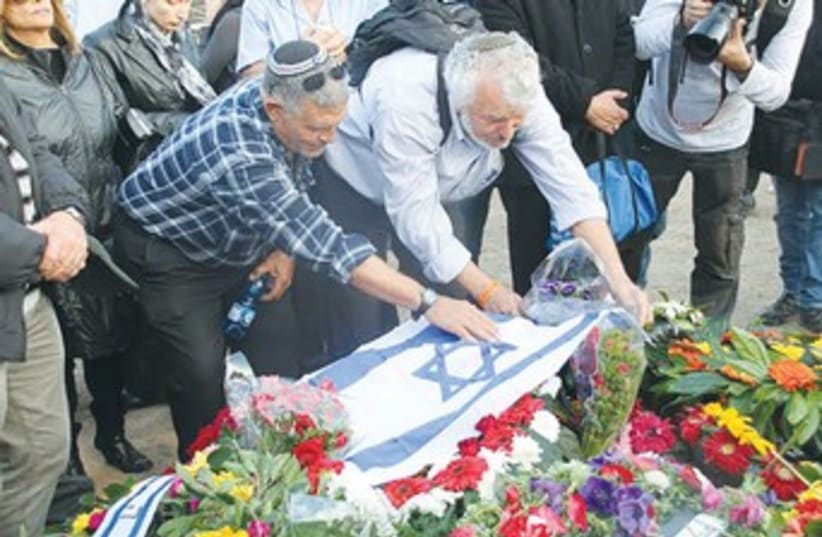Gaza evacuee Avi Farhan on Monday spontaneously spread an Israeli flag over the grave of former prime minister Ariel Sharon who had twice destroyed his home, once in Yamit and again in Elei Sinai.Once he had straightened out the bright blue and white cloth over the mound of floral wreaths, Farhan left his business card, which states: “We’ll remember and we won’t forget.”Then the gray-haired man, whose life was twice turned upside down by Sharon, saluted the grave, with the same hand, whose wrist still sports a plastic orange bracelet, a left-over symbol for the 2005 battle to save the 21 Gaza settlements from demolition.
“Just like for everyone, this is a very sad day for me,” he said of the passing of the man with whom he had rallied and against whom he had railed over Israel’s flag and its future.But there is also a physical Israeli flag that takes part of their joint history.After security forces, under the direction of then defense minister Sharon, came to demolish the Sinai settlement of Yamit in 1982, Farhan went to the community’s flagpole.Aside from the army, Farhan said, “I was the last person there.”With the help of a soldier, he took the flag and marched with it in the direction of Jerusalem, along with his wife and 12-yearold daughter.“My wife wanted [then-prime minister Menachem] Begin to look them in the eye and see what he had done,” Farhan said.He was determined, after a protest there, to build a tent city along Israel’s southern border, until he was allowed back into Yamit.As they neared Jerusalem, having garnered supporters along the way, they set up camp by Sha’ar Hagai.He recalled that it was in the spring, on the eve of Remembrance Day, and that they held a ceremony there.An emissary from Sharon met them there and urged Farhan to use his energies on behalf of the country, by helping to settle Gaza.“After Independence Day, I was in his office and they [Sharon and his staff] put forward all kind of maps, and the rest is history,” said Farhan as he spoke of the north Gaza settlement of Elei Sinai, by the sea, which had been his second home.In October of 2004, as the Knesset prepared to pass legislation that authorized the Gaza withdrawal that then prime minister Sharon had proposed, Farhan took the same flag, which had tattered over the years, and marched again to Jerusalem, but to no avail.“We [Sharon and Farhan] created the settlement, and he evacuated me from there,” said Farhan.A father of four, Farhan has yet to resettle. He now lives in a modular home in the north, near Neveh Yam, where he hopes to build a kibbutz.On Monday, Farhan traveled from there to Sharon’s Sycamore Ranch, near the Gaza border and his former home of Elei Sinai, to attend the afternoon funeral, out of a sense of respect and connection that has remained in spite of the pain and anguish, he said.As he spoke he sat briefly with The Jerusalem Post on a white plastic chair, which had not yet been stacked by workers cleaning up the area after Sharon’s funeral.In anticipation that his presence at the funeral would generate some questions, given the anger Gaza evacuees feel toward Sharon, he had hand written out some of his thoughts on a small piece of paper.“I came here because Arik and I had a deep connection, as a fighter in the army, as a friend, as a neighbor and as a settler,” said Farhan. “I want to remember him and the positive things that were between us and not the fights,” said Farhan.There was a time, Farhan said, that he could come on Friday’s with his children to visit Sharon at his home, located across the road, on a small hill opposite the one where he is now buried.Farhan said he believed that in the months following the August Gaza withdrawal up until he fell into a coma on January 4, 2006, Sharon had retreated the evacuation of the settlements.“What happened to him was because of the distress he was in, the emotion and the pressure,” said Farhan.“In my opinion he understand that he erred. Therefore I found it right to come here, and to remember Arik,” said Farhan.Gaza evacuee places Israeli flag on Sharon’s grave
Avi Farhan was removed from the Yamit settlement in Sinai and later Gush Katif, both on the orders of the former PM.
